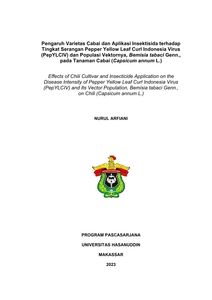Arfiani, Nurul (2023) Pengaruh Varietas Cabai dan Aplikasi Insektisida terhadap Tingkat Serangan Pepper Yellow Leaf Curl Indonesia Virus (PepYLCIV) dan Populasi Vektornya, Bemisia tabaci Genn., pada Tanaman Cabai (Capsicum annum L.). Thesis thesis, Universitas Hasanuddin.
![[thumbnail of G022202004_tesis_05-04-2023 cover1.jpg]](/41121/1.hassmallThumbnailVersion/G022202004_tesis_05-04-2023%20cover1.jpg)

G022202004_tesis_05-04-2023 cover1.jpg
Download (288kB) | Preview
G022202004_tesis_05-04-2023 bab 1-3.pdf
Download (1MB)
G022202004_tesis_05-04-2023 dp.pdf
Download (900kB)
G022202004_tesis_05-04-2023.pdf
Restricted to Repository staff only
Download (2MB)
Abstract (Abstrak)
PepYLCIV, the cause of chili yellow leaf curl disease, is currently widespread in Indonesia and can cause up to 100% yield loss. PepYLCIV is transmitted by vector, namely B. tabaci. Thus, the purpose of the current study was to determine: (1) the effect of using chili varieties with different resistance to PepYLCIV and different frequencies of insecticides application on B. tabaci population, (2) the effect of using chili varieties with different resistance to PepYLCIV on the incidence and severity of chili yellow leaf curl disease, and (3) production and percentage of yield loss due to PepYLCIV attack on two chili varieties that have different resistance to the virus. The current study was conducted at the Experimental Farm and the Laboratory of Insect Relations and Plant Disease, Faculty of Agriculture, Hasanuddin University, Makassar from June 2021 to February 2022. Molecular detection of PepYLCIV was conducted at the Biology and Molecular Laboratory of the Indonesian Cereals Research Institute, Maros, South Sulawesi. The experimental design used was a Split Plot Design. The main plots were chili varieties consisting of Baja MC F1 and Pilar F1. Sub-plots were the frequency of insecticide application which consisted of three levels, those are: not applied, applied once a week, and applied twice a week. Parameters observed were B. tabaci population, disease incidence and severity, as well as chili productivity which carried out every week (starting 23 days after planting). Data were analyzed descriptively (observing the characteristics of the symptoms macroscopically) and quantitatively using parametric and non-parametric tests at 5% significance level and continued with Duncan's test at 5% significance level. Quantitative analysis used SPSS for Windows Version 23. The results showed that statistically, the use of insecticides and varieties with different resistance to PepYLCIV had no effect on suppressing B. tabaci populations during the rainy season. The use of resistant varieties can reduce the incidence and severity of chili yellow leaf curl disease and show less yield loss.
| Item Type: | Thesis (Thesis) |
|---|---|
| Subjects: | S Agriculture > S Agriculture (General) |
| Divisions (Program Studi): | Fakultas Pertanian > Ilmu Hama dan Peny. Tumbuhan |
| Depositing User: | Nasyir Nompo |
| Date Deposited: | 09 Jan 2025 06:41 |
| Last Modified: | 09 Jan 2025 06:41 |
| URI: | http://repository.unhas.ac.id:443/id/eprint/41121 |


